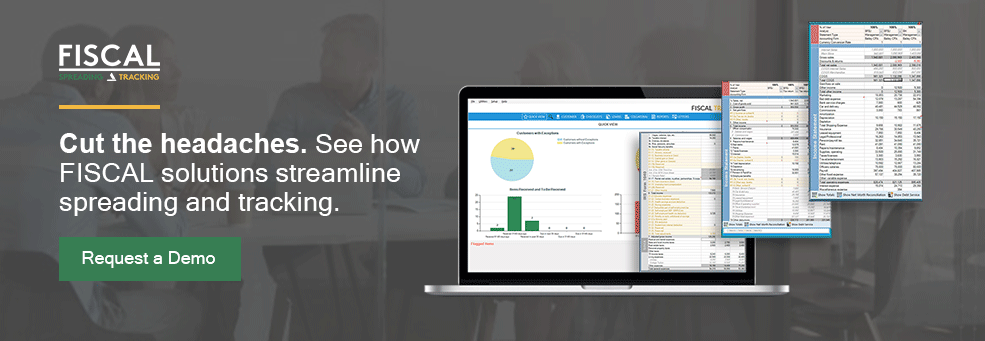If there’s one constant in tracking, it’s that the specifics of what is tracked changes from customer to customer. What exceptions are tracked and how they’re tracked can even vary between officers within the same financial institution.
The lack of consistency in exception tracking may work for individuals, but it’s often not the best approach for the institution. Unless there’s a standardized process in place that aligns with tracking best practices, it can cost small banks and credit unions hours of painstaking sorting and filtering within spreadsheets to pull a list of loans with items that are past due, coming due or those missing documentation.
By establishing a few exception tracking best practices, banks can save hours, even days, spent on tracking tasks.
Why exception tracking in Excel is challenging
Excel had long been the go-to method for small banks and credit unions. The formulas and flexibility are able to meet the needs of community banking and small business lending as they grow.
However, the flexibility of Excel can also lead to inconsistencies that stray from the best practices that were initially established, or in some cases, were never established in the first place.
In this post, we’ll look at how small institutions can restore best practices in Excel, as well as opportunities to standardize practices with exception tracking software.
Exception tracking best practices for banks and credit unions
The best practices for exception tracking may look different depending on your technology stack, your resources, and the size of your organization. In general, you should consider searchability, due date tracking, scalability, contact naming conventions, and internal contact documentation when developing exception tracking standards.
Let’s dive in:
1. Think about searchability, not saving time
Efficiency and saving time is always on the minds of loan officers, which is why many will create shortcuts, abbreviations, and consolidate multiple items together. The unintended consequence is that it complicates the sheet and the ability to properly track items.
One common time-saving shortcut is using abbreviations for the names and tracked items. But too often there is a lack of consistency within the sheet. When entering personal financial statements, one cell might spell the item name out, and elsewhere it is abbreviated, such as personal financial statement in one cell and PFS in another.
Other times, tracking administrators may input multiple items into one cell. When separate documents are included in the same cell, such as tracking tax returns and personal financial statements, there’s no way to indicate which documents have been received and which are past due.
While this is all done in the spirit of saving time, these shortcuts will eventually slow down other tracking processes and make the tracking spreadsheet difficult to search, and hinder the use of formulas and tables.
To adhere to best practices, individual documents, the effective year of the document, and when they are due to the institution should all be tracked in separate cells in the tracking spreadsheet.
2. Properly track due dates
Similar to creating individual cells for each document and their years, small banks and credit unions should also put forethought into tracking due dates and effective dates.
Including a due date in a tickler system is essential in exception tracking, yet it fails to show at a quick glance which items are coming due. Borrowers certainly prefer to receive notification that information is needed soon, as opposed to learning without notice that documentation is past due.
But without a clear way to view this in the sheet, tracking administrators may miss when items are coming due and cause their borrowers frustration. No one wants to scramble to provide the information they should have been notified was due weeks earlier.
Excel offers a number of features that can help you see when items are coming due or are overdue, providing color coding options to alert loan officers.
FISCAL TRACKING offers a similar feature, allowing for customizable reports and letters. By aligning due dates with specific times for documentation requests, banks can provide better customer service with ample notice of coming due items or avoiding requests during busy times.
Due Date from/to filters let you capture items coming due in the near future, not just items that have already fallen past due
![]()
Due Date filters can be set specifically, or default to pre-set values like “Last day of current month"
![]()
3. Create a system that scales
Small banks and credit unions set up systems meant to work for them. Right-sizing tools and software is critical to both the bottom line and the efficiency of the employees. While the systems may work well today, there should also be an eye toward future growth and how those systems will hold up as the portfolio expands.
The best approach is to implement an exception tracking system that’s designed to scale. While the features and formulas may seem over-engineered for your needs today, adding customizable templates, alerts, and automation for letters and reports can save tracking officers significant time as the lending portfolio grows.
Exception tracking software offers the unique ability to move beyond cumbersome spreadsheets and enables you to start automating your tracking processes.
4. Document contact names
Many small business owners have multiple companies or are intertwined with other business entities. To get the full scope of the account, you need a tracking system that can connect all related businesses and business entities, including who is responsible for submitting documentation.
The correct contact for items needed in exception tracking isn’t always the borrower. It could be another person at a related entity. Without this information, tracking administrators can spend days or even weeks tracking down the correct contact for each document. Taking the time to include a column for document contacts enables faster sorting and creation of letters.
Implementing this best practice into a tracking system also makes it easier for an institution to incorporate automation.
FISCAL’s exception tracking software can pull the contact information in seconds for generating letters, saving hundreds of hours a year.
5. Document internal contacts
When using an Excel-based exception tracking system, tracking administrators often have to spend their time generating past due lists and manually creating letters. This often puts the task of collecting items to the loan officers. In some cases, this leads to hours spent each month chasing documentation instead of focusing on customer service and bringing in new deals.
When it comes time to request documentation, adding a column in Excel to quickly see which loan officer handled the account can save tracking administrators time and frustration.
This information is also included in FISCAL TRACKING, giving tracking administrators the ability to run a report and send an automated email each month alerting each loan officer of items past due or coming due for collection.
Reports can be scheduled to run daily, weekly, monthly, etc.
![]()
Auto-Generated reports can be emailed to the responsible Officer, Committee, etc.
![]()
Streamlining the collection process not only prevents frustration, it helps community banks become more proactive, resulting in a higher response rate from borrowers.
How to use exception tracking software to streamline your processes
These best practices can be implemented in Excel with training and a policy that requires standardized exception tracking. It can also be easily adopted with exception tracking software like FISCAL TRACKING.
Out of the box, FISCAL TRACKING allows you to improve standardization and consistency which allows you to increase efficiency in your tickler tracking process.
FISCAL helps community banks and credit unions streamline operations while maintaining the high degree of flexibility required in small business lending.
Want to learn more about how your credit union or community bank can benefit from exception tracking software? Contact us today for a no-nonsense demo of FISCAL TRACKING today.


